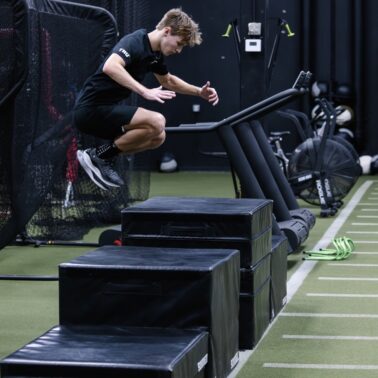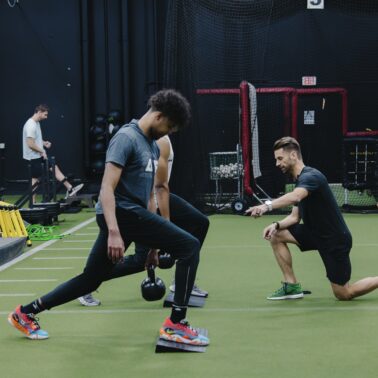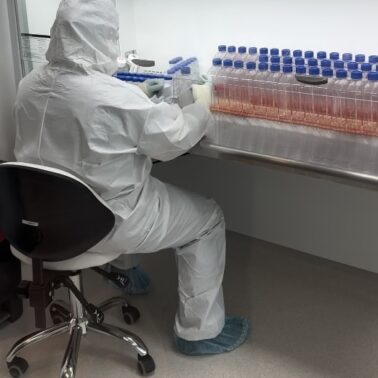“The internal hormonal response that exercise creates can help optimize the neuroplasticity needed for motor learning during rehab.”
Adam Loiacono
What You Will Learn
- Why exercise goes way beyond physical adaptations.
- How exercise stimulates Brain Derived Neurotrophic Factor (BDNF).
- Effective strategies to take advantage of the hormonal response from exercise to improve motor learning during rehab.
Understanding Motor Learning
Motor learning, a multifaceted neurological phenomenon, encompasses the acquisition and refinement of motor skills. It’s particularly pivotal in rehabilitation, where patients often must relearn fundamental movements such as walking, or regain fine motor skills like gripping or manipulating objects. This intricate process hinges on a blend of factors: the patient’s neurological health, which includes brain function and neural connectivity; their physical condition, encompassing muscle strength and endurance; and the specific nature and severity of the injury or medical condition being addressed.
Factors like age, prior skill level, and the presence of coexisting medical conditions also significantly influence the efficacy and pace of motor learning. The adaptability of the nervous system, known as neuroplasticity, plays a critical role, enabling the brain to rewire itself in response to physical therapy and practice. Thus, personalized rehabilitation programs, attentive to these diverse factors, are essential for effective motor relearning and recovery.
Hormones: The Hidden Players in Rehabilitation
Hormones are biochemical messengers that play a pivotal role in bodily functions, including muscle growth, mood regulation, and cognitive functions. In rehabilitation, hormones such as cortisol, testosterone, growth hormone, and endorphins are particularly significant. They influence muscle repair, stress response, mood, and pain perception, all of which are crucial in the recovery process.
Cortisol and Stress Response in Rehabilitation
Cortisol, often referred to as the ‘stress hormone,’ is released in response to physical or psychological stress. While acute cortisol release can be beneficial for mobilizing energy reserves and managing stress, chronic elevation can impede rehabilitation by slowing down tissue repair and negatively impacting mood and motivation.
Testosterone and Muscle Recovery
Testosterone plays a vital role in muscle growth and repair. In rehabilitation settings, maintaining optimal testosterone levels is essential for effective muscle recovery and strength development. Exercise regimens in rehabilitation often aim to optimize testosterone levels to enhance muscle repair and growth.
Growth Hormone and Tissue Repair
Growth hormone is crucial for tissue repair and regeneration. It stimulates the production of collagen, a key component of muscle and connective tissues. During rehabilitation, exercises that promote growth hormone secretion can accelerate the healing process and improve recovery outcomes.
Endorphins: The Natural Pain Relievers
Endorphins, often called ‘feel-good hormones,’ are released during exercise. They play a significant role in pain management and mood enhancement. In rehabilitation, harnessing the power of endorphins through exercise can reduce the perception of pain and improve the overall mood and motivation of patients.
Influence of Exercise on Motor Learning: Insights from John Ratey’s ‘Spark’
In his groundbreaking book, “Spark: The Revolutionary New Science of Exercise and the Brain,” John Ratey, MD, provides compelling evidence on the profound impact of exercise on the brain and its functions. Ratey’s research particularly underscores how exercise can significantly enhance motor learning, a critical component in rehabilitation.
Ratey explains that exercise boosts brain function by increasing blood flow, which in turn enhances the delivery of oxygen and nutrients. This enhanced brain environment facilitates the growth of new brain cells and the formation of new neural connections, a process essential for learning new motor skills. According to Ratey, exercise induces the release of brain-derived neurotrophic factor (BDNF), a protein that supports neuron growth and improves brain plasticity. This neuroplasticity is the foundation upon which motor learning builds.
In the context of rehabilitation, this means that incorporating exercise into therapy regimes can markedly improve the rate and quality of motor learning. When patients engage in regular physical activity, they not only strengthen their muscles and improve physical endurance but also catalyze their brain’s capacity to learn and retain new motor skills. Ratey’s work suggests that exercise is not just about physical health; it’s a powerful tool to rewire and strengthen the brain, making it an indispensable element in the rehabilitation process.
Through his insightful research, Ratey has opened new doors in understanding how exercise transcends physical benefits and becomes a pivotal element in enhancing cognitive functions, including motor learning. His work serves as a guide and inspiration for rehabilitation specialists to integrate exercise more deeply into their therapeutic approaches.
Principles of learning: Insights from Peter Brown’s ‘Make It Stick’
Peter Brown, in his influential book “Make It Stick: The Science of Successful Learning,” dives into effective learning strategies, offering insights that can be applied to motor learning in rehabilitation. While Brown’s focus is broadly on learning techniques, his principles align seamlessly with the role of exercise in enhancing motor learning.
One of Brown’s key arguments is that learning is most effective when it’s effortful. In the context of motor learning, this translates to the idea that exercises which challenge a patient’s current capabilities are more likely to result in lasting improvements. Exercise in rehabilitation, therefore, should be designed to be progressively challenging, pushing patients slightly beyond their comfort zones to facilitate better motor skill acquisition and retention.
Brown also emphasizes the importance of retrieval practice – the act of recalling information or skills – which strengthens memory and learning. Applying this concept to motor learning, repeated practice of motor skills during exercise sessions helps in solidifying these skills. By engaging in varied exercises that target different motor skills, patients can enhance their ability to recall and perform these movements more effectively.
Moreover, Brown discusses the benefits of spaced repetition in learning. In rehabilitation, this can be interpreted as incorporating regular intervals of exercise and practice sessions, which are spaced out over time, rather than intense, infrequent sessions. This approach aligns with the principles of neuroplasticity and motor learning, as it allows the brain time to assimilate and build upon new motor skills.
Incorporating Peter Brown’s learning principles from “Make It Stick” into the exercise regimens of rehabilitation can significantly improve the efficacy of motor learning. By making exercises effortful, engaging in repeated and varied practice, and adopting spaced repetition, patients in rehabilitation can achieve better and more lasting improvements in their motor skills. Brown’s work thus provides a valuable framework for designing effective exercise-based rehabilitation programs.
Conclusion
Rehabilitation, a critical process for recovery, intertwines the roles of hormones, exercise, and motor learning. Motor learning, a neurological phenomenon, is essential for patients to reacquire movements or fine motor skills. This process is influenced by neurological health, physical condition, and the injury’s nature and severity. Hormones like cortisol, testosterone, growth hormone, and endorphins play vital roles in muscle repair, stress response, and pain perception, impacting recovery.
John Ratey’s research in “Spark” highlights exercise’s profound impact on brain function and motor learning, emphasizing its necessity in rehabilitation. Peter Brown’s “Make It Stick” offers insights into effective learning strategies, suggesting that challenging exercises, repeated and varied practice, and spaced repetition can significantly enhance motor skill acquisition.
Incorporating these principles into rehabilitation can lead to more effective and lasting improvements in motor skills, underlining the importance of a holistic approach that integrates physical and cognitive aspects of recovery.



